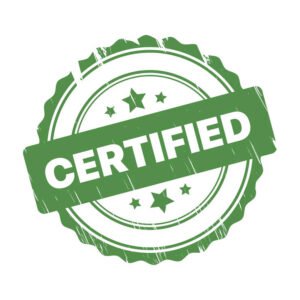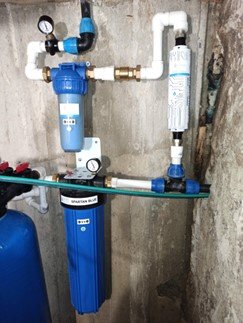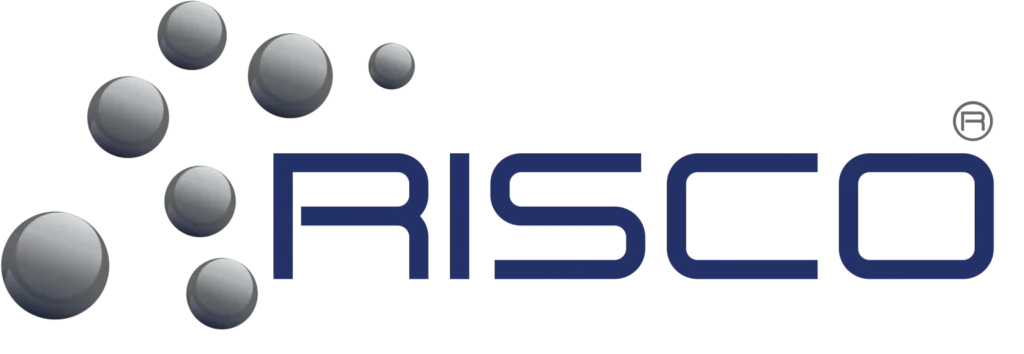Drinking Water Disinfection
What makes our CLAIRE QUANTUM DISINFECTION CRYSTALS so special?
This groundbreaking innovation will revolutionize the way we approach hygiene, health, and sustainability. This cutting-edge technology harnesses the intricate principles of quantum mechanics to forge a new frontier in disinfection. By utilizing the mesmerizing dance of electrons, it engineers catalytic active surfaces with a positively charged demeanour, armed to combat the invisible threats that surround us.
In an era where the need for rapid, effective, and eco-conscious solutions is more pressing than ever, this innovative marvel stands as a beacon of hope and progress. With the power to instantaneously disintegrate any microorganism upon contact, this technology holds the potential to reshape the very fabric of our lives – from safeguarding public health to protecting our delicate ecosystems.
Its implementation marks not just a leap forward, but a monumental stride towards a safer, cleaner, and more resilient future for all.
With CLAIRE QUANTUM DISINFECTION CRYSTALS


Human Benefits
Healthcare Facilities: Medical Equipment and PPE;
Water and Sanitation: Accessible Clean Water;
Food Industry: Enhanced Food Safety;
Public Transportation: Reduced Disease Transmission;
Educational Institutions: Healthier Learning Environments;
Emergency Response: Protection for First Responders;
Elderly Care Facilities: Improved Care for Seniors;
Remote Areas: Access to Clean Water.
Animal and Plant Life Benefits
Aquaculture: Sustainable Fishery Practices;
Agriculture: Enhanced Crop Health and Yield;
Aquatic Ecosystems: Biodiversity Preservation;
Terrestrial Ecosystems: Sustainable Plant Growth;
Animal Welfare: Disease Control in Livestock;
Epidemic Preparedness: Limiting Disease Spread;
Environmental Stewardship: Reduced Chemical Dependency;
Biodiversity Conservation: Wildlife Habitat Protection.
No power. No chemicals. No pathogens.
QUANTUM DISINFECTION
The future of water disinfection – A Technological Breakthrough
The UO2-Quantum Disinfection Innovation follows suit, a beacon of hope that illuminates a world where waterborne threats retreat before the might of human ingenuity.
Quantum Disinfection™
A revolutionary technology that uses the quantum mechanic principles of electron movement in order to create powerful catalysts with highly activated surfaces is applied now, for the first time, for water disinfection.
The Quantum Crystals ™
(ceramic: alumina-based, environmentally friendly, insoluble, and odourless),
Using a new technology based on the quantum mechanic principles of electron movements in micro-crystals that create active surfaces (positively charged with electron holes) capable to lyse the cells of microorganisms, like for example, the non-pathogen E. coli bacteria (strain 11775), causing their entire structure to collapse.

The Quantum Crystals ™ work is based on a new phenomenon – the “knife effect”: lysis of the non-pathogen microorganisms’ cells.
High Flows
The QC ceramics can be applied for high-flow water extra-purification in industries like beverages, poultry and agriculture:
Site-specific engineering may be required. (189 L/m and more)
What is it?
Quantum Disinfection™ (QD) is a new technology that uses the quantum mechanic principles of electron movement to create catalytic active surfaces (positively charged) that can disintegrate any microorganism instantly, upon contact.
In more detail, QD refers to (1) a technology that allows the creation of (2) new composite materials with (3) particular disinfection capacities:
– (1) The QD technology uses the general principals of the “Doping” technique, recently discovered in the field of advanced semiconductors, coupled with the high disinfection proprieties of cationic Silver;
– (2) The QD media represents alumina-based ceramics (fig. & tab. here bellow) tuned with one layer of titanium dioxide (called Acceptor Support) and another layer of silver (called Active Phase). These two layers influence each other and create at the alumna surface a strong cationic field, + 1.4 eV (called Active Surface);
– (3) The QD phenomenon is related to the disintegration of the microorganisms that touched the Active Surface of the QD media. The strong cationic field attracts and rips off the electrons from the external membranes, enzymatic layers or DNA-reproducible sequences of any microorganism that gets into direct contact with the QD media.

Are the QC ceramics a filter?
No, it’s not a filter. It is a water purification medium. Besides, it needs a primary filtration (at least 5 microns) to work properly, otherwise, the activated sites can be clogged.
How does it work?
Obviously, the germicidal capacities of the QD media are acquired due to the presence of the silver at their surface. At the same time, besides the efforts of scientists from all over the world, the action mechanism of silver against microorganisms remains not entirely understood. Our hypothesis for our QD silver-based product is the following:
The silver at the QD surfaces is in a high cationic state (1.4 eV). This electron discharge is achieved due to the presence of the TiO2 layer which, in the QD spacial spatial arrangement, size and bonding level, influence the Ag layer as follows: the big cation Ti4+ of the TiO2 (the layer called “Acceptor Support”), attracts closer to it the electrons from the silver above (Step 1, fig.).

- Due to the Ag high conductivity capacities, this effect migrates through the silver aggregates up til their surfaces. As a consequence, the surface of the QD media found itself in lack of electrons and acts just like a discharged active field powerful enough to rip off the electrons (e-) from any microorganisms with which it comes into direct contact (Step 2).

- Moreover, once removed from the microorganisms (MO), the e- are instantly released in the water, without any influence on the electron discharged field at the surface of the QD media (Step 3).

- This catalytic behaviour induces a permanent germicidal activity ensuring that no microorganism can stay alive once in contact with Quantum Disinfection™ media.
In conclusion, the QD electron discharged field causes the entire structure of the microorganisms to collapse at the quantum level, instantly, at contact. TPC measurements confirm the bacteria (E. coli) DNA is also instantly destroyed in this electron exchange. Any microorganism that touches the Quantum Disinfection™ media ceases to exist completely.
What microorganism it can kill?
The germicidal capacities of the Quantum Disinfection™ media were intensively tested at Claire Technologies Microbiologic Laboratory using Esherishia coli streams, and at least 3 years of data are available upon request.
Several other institutions and certified laboratories tested the QD media as well. Their results are also available upon request: – Environmental Protection Agency (EPA – USA); Guangdong Detection Center of Microbiology (GDCM – China); Institute for Environmental Health and Related Product Safety, Chinese Center for Disease Control and Prevention (IEHRPS – CCDCP – China); – Avazyme (USA); Eurofins (France, USA); Microbac (USA); Proteus (France); Ackuritlabs (USA); University of Wisconsin (USA); QFT Laboratory, LLC (USA);
A summary of all the results is presented in the following table:

Are the QC ceramics certified?
YES

- a NSF Certified Component to NSF/ANSI 42 for material requirements only USA(Certificate of listing #: C0292640-01)
- a IAPMO Certified Component to NSF/ANSI 61 for material requirements only USA(Certificate of listing #: W-10747)
- a MOH Certified Component to GB/T 5750-2006 Standard for material requirements only – China (Certificate of listing #: 2015KF2513)

How long do the QC ceramics last?
Theoretically, forever. In practice, it all depends on the inlet water quality. Claire works closely with our Soldevco Pty Ltd/Ultra-Oxygen to design cartridges and devices that meet end-of-life criteria. For Claire’s own systems, such as the PLATINUM unit (see Products), the warrantied life is 757 082 litres or over 1 year of normal household use.
Operational Parameters
The main purpose of using the technology is to ensure DRINKING water, and water used in processes where no pathogens are allowed to be present.

5 Micron pre-filtration is strongly always recommended.

How we outperform our competition.
Introduction
The majority of technologies used for water disinfection are divided in between the following methods: Chlorination, UV-lights and Ozonation. Some other chemicals, like peroxide, bromide and silver are also rarely used, mainly for bathing water disinfection.
Ultraviolet vs Quantum Disinfection™ (UV vs QD)
Ultraviolet germicidal irradiation is a disinfection method that uses short-wavelength ultraviolet (UV-C) light to kill or inactivate microorganisms by destroying nucleic acids and disrupting their DNA, leaving them unable to perform vital cellular functions. The below table provides the items and reasons why it is a greener option to disinfect your drinking water with CLAIRE QUANTUM DISINFECTION CRYSTALS.

Chlorination vs Quantum Disinfection™ (QD)
QD can be considered an alternative disinfection method to Chlorination for small communities, rural areas and villages. In this case, the cost of QD is approximately 9-10 times cheaper than Chlorination.
Why is chlorine in drinking water dangerous?
When chlorine mixes with even minute amounts of organic compounds that are very often found in water, they produce harmful by-products, called Trihalomethanes (THMs). These by-products produce free radicals in the body, which trigger cell damage.
It has been reported that tap water with a 0.5 ppm chlorine content can be used to kill bacteria and remove pesticides. However, these reports fail to mention that in order to achieve such a result water temperature must be below 5 degrees Celsius. Chlorine will evaporate at higher temperatures thus rendering tap water unable to remove pesticides and kill bacteria.
Food purchased from supermarkets may not have been thoroughly cleaned and may contain bacteria. If it is not cleaned well bacteria such as salmonella and e. coli can cause diarrhea and infection if consumed. According to Yang Ming Medical University test reports Ozone Antibacterial Sanitizers are capable of removing 99% of salmonella in 10 seconds. In order to achieve similar results with similar concentrations of chlorine, food would need to be washed for 15,000 seconds.
Because there are some contaminants that are molecularly smaller than water, Reverse Osmosis isn’t always the silver bullet many people expect when it comes to providing water that’s completely free of impurities. For example, some common contaminants that can slip through the average RO filter are: Pesticides; Herbicides; Many other agricultural treatment products like fungicides; Some dissolved gasses, like hydrogen sulphide; and Certain organic compounds.
Chlorine — RO can remove various quantities of chlorine, but there is a possibility that the average home RO filter may not have the capacity to capture all the chlorine present in water, though this will largely depend on the chemical concentrations in the water supply.
Reverse osmosis process discards 75% or more of the water. That means for every 20 litres of reverse osmosis water, 15 litres or more is returned to the drain as a highly concentrated salt and contaminant mix. So 35 litres of water is used to make 20 litres of water. More water is used for washing the bottles and for other processes. In the end, reverse osmosis filters polluted tap water and uses more than double the volume of the bottle.
But why is everyone doing it?
Unfortunately, some companies don’t follow guidelines. We follow WHO – World Health Organization – as they are the official body taking care of the planet’s health.
WHO outlines the danger of drinking reverse osmosis water from commercial systems or from home RO systems. The minerals added to the water after reverse osmosis don’t follow WHO guidelines which expect the water quality to mimic nature at least with the most important minerals like calcium, magnesium and bicarbonates. Unfortunately for companies and for household units the required minimum of 100mg/L TDS, is not followed. The reason? It doesn’t make any viable monetary sense to add the required amounts of minerals back into the water. Some companies now sell home Magnesium cartridges that add the mineral back into the water. Magnesium cannot be absorbed effectively without calcium and not in RO water.
This is somewhat better than no magnesium, but it is still highly ineffective since the minerals are added to reverse osmosis water.
RO water is highly unstable and undergoes natural osmosis as soon as it gets a chance. Because RO water lacks minerals and has a very low TDS count, it will leach minerals from the cells of your body when drinking it. It will leach ions, salts and minerals. You will then urinate all the good minerals out leaving you thirsty, demineralised, and un-hydrated.
The health effects are far-reaching, from cardiovascular disease to hormone problems. This is because of the unnatural state of the water which causes bodily cycles to be disrupted and can cause catastrophic organ failure.
RO systems and tanks are prone to bacteria growth if not cleaned regularly. This is not very practical as production would need to stop every few hours because RO water is the perfect environment for bacteria and viruses. At home, cleaning and maintenance become a chore and are discarded, letting bacteria grow.
Bacteria can grow in RO water because it has a low pH, (typically 4-6.5) and due to the lack of minerals in the water, it is often treated with chlorine to kill bacteria and viruses which damages the RO membrane after prolonged use. The chlorine must be in 5 degrees Celsius water or less to be effective. This is because chlorine boils in water more than 5 degrees Celsius and evaporates. The chlorine effectiveness of un-chilled water will be from a few minutes to a few hours and only at treatment plants and bottling plants. This means during the water’s journey in pipes from the treatment plant, it’s completely unprotected and at the bottling plant, Chlorine will not be effective if the manufacturer hasn’t spent the capital to chill the water for treatment, which is very expensive.
Some bacteria, viruses, hormones, pathogens, and other toxins are smaller than water molecules, therefore RO systems and other filters are ineffective if the water is contaminated. Basic pathogen tests indicate that the water in South Africa is contaminated in most provinces. Within major municipalities, where we would assume the water is safe to drink, we cannot find any test results for any pesticides, nitrites, hormones, or pathogens. The main test results are of E. coli which is insufficient.
Sufficient evidence is now available to confirm the health consequences of drinking water deficient in calcium or magnesium. Many studies show that higher water magnesium is related to decreased risks for CVD and especially for sudden death from CVD. This relationship has been independently described in epidemiological studies with different study designs, performed in different areas, populations, and times. The consistent epidemiological observations are supported by the data from autopsy, clinical, and animal studies. Biological plausibility for a protective effect of magnesium is substantial, but the specificity is less evident due to the multifactorial aetiology of CVD.
In addition to an increased risk of sudden death, it has been suggested that intake of water low in magnesium may be associated with a higher risk of motor neuronal disease, pregnancy disorders (so-called preeclampsia), sudden death in infants, and some types of cancer. Recent studies suggest that the intake of soft water, i.e. water low in calcium, is associated with a higher risk of fracture in children, certain neurodegenerative 159 diseases, pre-term birth and low weight at birth and some types of cancer. Furthermore, the possible role of water calcium in the development of CVD cannot be excluded.
https://www.who.int/publications/i/item/9241593989
Cooking with RO water is not recommended. Due to the unstable water, it leaches all the minerals. Studies have shown more than 65% of nutrients and minerals will be drawn from the food into the water leaving the food with insufficient nutrients.
Taking all the above into consideration it makes logical sense to use Quantum Disinfection™ technology to disinfect your drinking water since it is disinfecting the water without the use of chemicals.
AVAILABLE PRODUCTS
Support
Applying the product on large-scale projects would require assistance and the development of an application methodology and execution plan.
Below is the available product range:

How does it look inside?

Where to use?
General
The Quantum Crystals ™ systems or media have to be installed just after all your purification systems (after softeners, heavy metals removal systems, filters, Reverse Osmosis systems, pitcher filers, or any other water purification device) and, it should be considered as a compliment installed or implemented at the last stage of all water purification systems. (at the Point-of-Use only)

Residential

Recreative Vehicles

Commercial

Agriculture

SUPERIOR PRODUCT ADVANTAGES
General
Here’s a side-by-side table that outlines the advantages of using quantum disinfection for drinking water treatment and adding Ultra-Oxygen Microbubbles (MB) and Ultrafine Bubbles (UFB) technology to the process:

It’s important to note that the effectiveness of this combined approach depends on factors such as the design and implementation of the quantum disinfection system, the concentration and distribution of oxygen micro and ultrafine bubbles, and the specific water quality and pathogens encountered. Testing and optimization are typically required to achieve the best results for a particular water treatment application.

